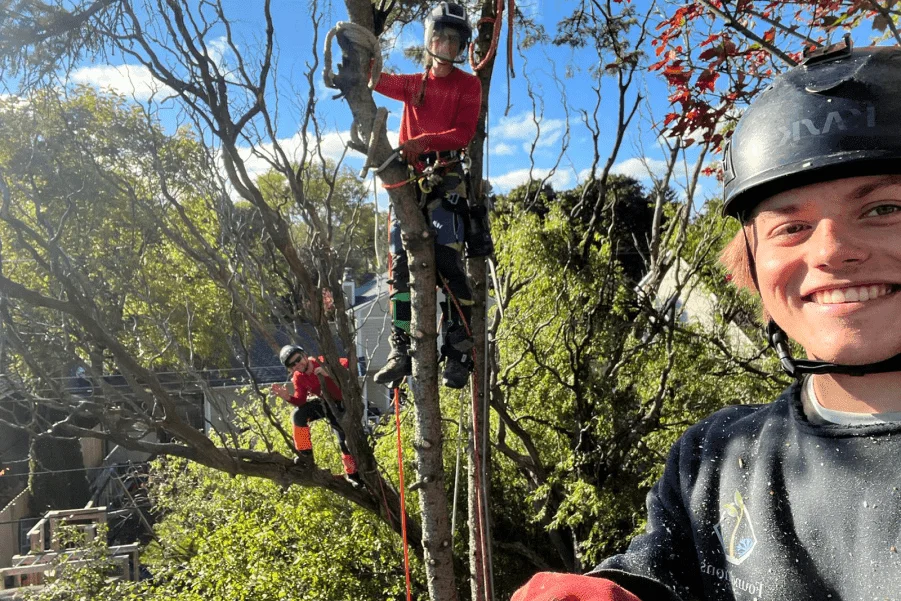Can I Use My Tree As Firewood?
The most important variable you’ll need to know about regarding different tree species as firewood is their heat output. This is typically measured in BTUs per cord. BTUs are British thermal units, and a cord is a pile of split, dried, stacked firewood measuring four feet high, four feet deep, and eight feet wide, or 128 cubic feet. If any of these terms are new to you, they’ll all make more sense in a minute.
Basically, different woods burn at different temperatures. Usually, harder woods will burn hotter—your white oak may be harder to light on fire initially, but will create more heat for a longer period of time than, say, your willow or pine. This means more heat, fewer trips to the wood burner, and less wood you need to have stockpiled to get through the winter.
——————————————————————————————————————————
To keep things relatively simple, let’s talk about three different categories of wood. Tier one will be the really premium woods—the ones that burn at or above 24 million BTUs per cord. These are the woods that are worth spending some extra money (and are the only woods we sell as firewood at Dungrove.) Here’s a list of common trees in this area that fall into this category, along with their average BTU outputs (in millions of BTUs/cord.)
Shagbark hickory — 27.7
White oak — 25.7
Black locust — 26.8
Eastern redbud — 24.9
Honey locust — 26.7
Sugar maple — 24.0
Apple — 26.5
American beech — 24.0
Mulberry — 25.8
Red oak — 24.0
——————————————————————————————————————————
——————————————————————————————————————————
Tier two will be woods that produce between 19 and 24 million BTUs per cord. These may not be worth cutting, splitting, stacking, and seasoning for commercial sale, but if you can find it for free and you’ve got a chainsaw and an axe, go ahead and cut it up and it’ll make fine firewood. Here are some of those.
River birch — 21.0
Sweetgum — 19.7
Northern hackberry — 20.8
American elm — 19.7
Paper birch — 20.3
Siberian elm — 19.7
Black walnut — 20.2
Sycamore — 19.5
Black cherry — 19.9
Silver maple — 19.3
——————————————————————————————————————————
Tier three will be the woods that, well… we’d recommend not wasting your time. These woods produce fewer than 19 million BTUs per cord. This means you’ll spend a lot of time processing, you’ll have to have lots of it on hand, and you’ll need to top off the stove often. That said, really any wood is fine to burn outside if you just want to make s’mores at the campground. But as far as burning inside goes, we’d pass on these ones.
Eastern redcedar — 18.9
Quaking aspen — 14.7
Red maple — 18.7
Weeping willow — 14.5
White spruce — 18.1
Eastern white pine — 14.3
Tuliptree — 18.0
Eastern cottonwood — 13.5
Northern catalpa — 16.3
Arborvitae — 12.2
——————————————————————————————————————————
Some additional interesting notes about firewood:
A tree’s genus—not just its species—is very important to consider. People often talk about burning “maple,” but not all maples are created equal. Burning a cord of sugar maple, for example, produces 24 million BTUs. Burning the same amount of boxelder maple, however, will only produce 17.9 million BTUs. That’s a really significant difference. The same phenomenon happens with other species. Scots pine (19.3) vs. white pine (14.3.) Black cherry (19.9) vs. pin cherry (15.4.) So next time someone offers to sell you some “maple” firewood, it may be worth it to ask, “which maple?”
One of the best firewood species in the world is called osage orange. It’s a relatively small, extremely dense tree with huge, softball-sized green fruit. One cord of it produces 32.9 million BTUs, but alas, it’s native to the southern US and is very rare in Michigan. But as a fun (and perhaps helpful) thought experiment, let’s imagine heating a small house for one winter with osage orange vs. with northern whitecedar (12.2.) Two cords of osage orange would take up 64 square feet of your yard. To produce the same amount of heat, you’d need 5.4 cords of whitecedar, which would take up 173 square feet of your yard. You may need to add more osage orange to the stove every four hours. To maintain the same level of heat, you’ll have to add more whitecedar every 89 minutes.
All woods need to be cut to cut, split, stacked, and seasoned. “Seasoning” refers simply to letting them dry—not applying salt and pepper. This process can take anywhere from eight months to two years, depending on the type of wood and the conditions under which it is seasoning (rain, airflow, humidity, temperature, etc.) Harder woods generally take longer to season properly than soft woods.
A hot take from Dungrove: keep an eye on honey-locust. It seems that, years ago, every land developer in the state got together and decided these were going to be the hot new landscape tree. Now everyone’s got one, and we’ve realized how fast they grow, how quickly they get unruly, how often they need pruning, and how annoying their thousands of tiny leaves are. To clarify, I have no vendetta against honey-locusts—I think they’re perfectly nice trees. But people are having them pruned or removed in droves, and they’re some of the best firewood in the area. What’s interesting about them is that, generally, there’s a strong, inverse correlation between how fast a tree grows and how well it burns. Fast growers are bad burners, slow growers are good. Honey-locusts break this rule substantially. They can grow more than two feet per year (which is pretty fast for a tree) and produce more heat than oaks and almost as much as hickories.

